Allotments in the Future: Building Resilience to Climate Change through Improved Site Design and Efficient Water Practices
Abstract
1. Introduction
2. Methods
2.1. Methodology
2.2. Prototyping
3. Improving Efficiency of Water Use
3.1. Plant Density
3.2. Mulching
3.3. Weed Control
3.4. Directed Watering
3.5. Watering Requirements
3.6. Avoid Water Shortages
3.7. Grow Drought Tolerant Plants
4. How Much Water Is Needed on an Allotment?
5. Rainwater Storage and Collection
5.1. How Much Water Can Be Collected?
5.2. What Is the Optimum Structure for Rainwater Collection and Storage?
6. Cultivation and within Plot Layout
6.1. Paths and Beds
6.2. Greenhouse and Polytunnel
7. Site Layout
7.1. Paths
7.2. Pond and Wildlife Area
7.3. Different Sized Plots
7.4. Communal Building
7.5. Toilet
7.6. Mains Water Supply
7.7. Communal Composting Areas
8. The Allotment of the Future
- (1)
- Shared buildings: communal building, compost toilet and handwashing facility, mower/power tools shed.
- (2)
- Shared areas: communal patio, communal orchard, children play area, compost bays, unloading area for vehicles (deliveries of manure), car park (for bicycles, cars and optional bus/coach), optional raised beds for disabled and school use.
- (3)
- Individual plots: short and long beds, optionally raised beds for less able, polytunnels/greenhouses, netted area, livestock pens.
9. Conclusions
Supplementary Materials
Author Contributions
Funding
Informed Consent Statement
Data Availability Statement
Acknowledgments
Conflicts of Interest
Appendix A. Estimation of the Amount of Water Needed to Water Established Crops on an Allotment during the Summer
Appendix A.1. Background
| Winter | Spring | Summer | Autumn | |
|---|---|---|---|---|
| Rainfall (mm) | 329 | 237 | 240 | 343 |
Appendix A.2. Calculation of the Amount of Water That Might Be Needed to Water Plants in UK during the Summer Months
Appendix B. Example Calculation of the Amount of Water That Could be Collected from a Roof
Appendix C. Example Design of Water Collection Structure Using Scaffold Poles for the Framework
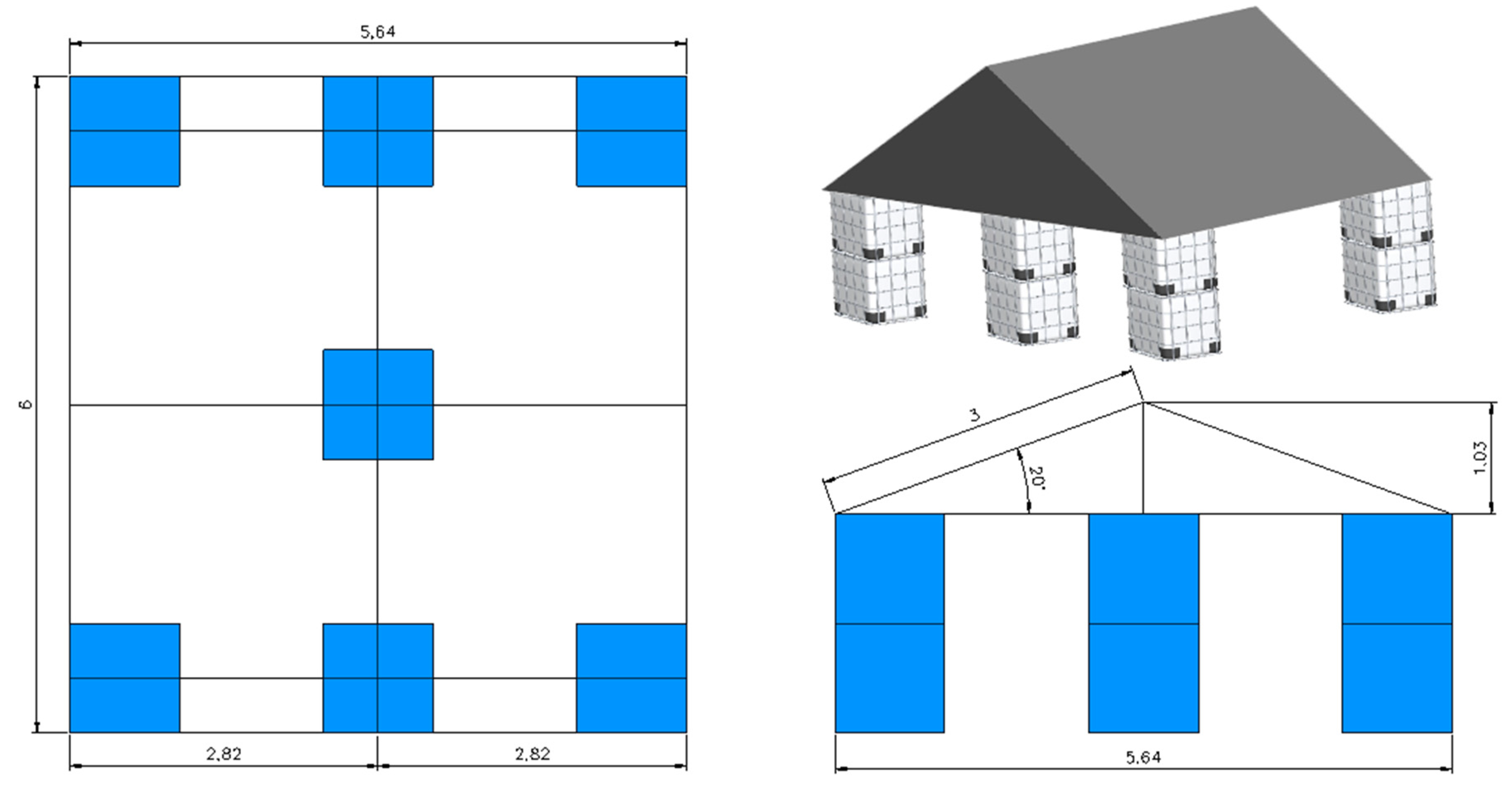
Appendix D. Watering Requirements (in the UK) of Some Widely Grown Outdoor Vegetables
| Type of Crop | Crop | How Much Water to Apply | When to Water If No Watering Limitation | When to Water If Watering Is Restricted | Comments |
|---|---|---|---|---|---|
| Leafy vegetables | Cabbage Kale Lettuce Spinach | 11–16 L m−2 once established | Each week | 2 weeks before cutting 22 L m−2 | Overwatering will cause the heads to burst |
| Brussels sprouts | 150 ml per plant per day when transplanted | No need to water after established except in very dry years | |||
| Fruiting vegetables | Peas Broad beans French beans Runner beans | 5–11 L m−2 | Twice each week throughout flowering and pod-growing periods | Once as first flowers open, and once as pods swell | Misting or spraying the flowers does not improve number of pods that set |
| Tomatoes Marrow cucumber | 10 L m−2 | Twice each week during flowering and fruit forming | Twice weekly during flowering and fruiting but can sink a pot into ground close to roots to ensure maximum amount of water is directed to the root | ||
| Root vegetables | Carrot Parsnip Beetroot radish | 5 L m−2 when young 16–22 L m−2 when storage roots growing | Every two to three weeks, before soil gets too dry | Watering (or rain) after a prolonged dry spell can cause the roots to split | |
| Potatoes | The watering requirements of potatoes depend on the type (early or main crop), and variety. The Royal Horticultural Society is a good source of general guidance. | https://www.rhs.org.uk/advice/grow-your-own/vegetables/potatoes, accessed on 4 February 2021 | |||
References
- Way, T. Allotments; Amberley Publishing Limited: Oxford, UK, 2017. [Google Scholar]
- Niala, J.C. Dig for vitality: UK urban allotments as a health-promoting response to COVID-19. Cities Health 2020, 1–5. [Google Scholar] [CrossRef]
- Business Insider. Available online: https://www.businessinsider.com/no-deal-brexit-percentage-british-food-imported-shortages-2019-1?r=US&IR=T (accessed on 2 March 2020).
- Rimal, A.P.; Moon, W.; Balasubramanian, S. Agro-biotechnology and organic food purchase in the United Kingdom. Brit. Food J. 2005, 107, 84–97. [Google Scholar] [CrossRef]
- Perez-Vazquez, A.; Anderson, S.; Wiltshire, R.; Fraser, R. Valuing non-market benefits derived from allotments in southeast England: A contingent valuation study. Int. J. Sust. Dev. World. 2010, 13, 103–112. [Google Scholar] [CrossRef]
- Soga, M.; Gaston, K.J.; Yamaura, Y. Gardening is beneficial for health: A meta-analysis. Prev. Med. 2016, 5, 92–99. [Google Scholar] [CrossRef] [PubMed]
- Kingsley, J.; Foenander, E.; Bailey, A. You feel like you’re part of something bigger: Exploring motivations for community garden participation in Melbourne, Australia. BMC Public Health 2019, 19, 745. [Google Scholar] [CrossRef]
- Edmondson, J.L.; Childs, D.Z.; Dobson, M.C.; Gaston, K.J.; Warren, P.H.; Leake, J.R. Feeding a city–Leicester as a case study of the importance of allotments for horticultural production in the UK. Sci. Total Environ. 2020, 705, 135930. [Google Scholar] [CrossRef] [PubMed]
- Lang, T.; McKee, M. Brexit poses serious threats to the availability and affordability of food in the United Kingdom. J. Public Health 2018, 40, e608–e610. [Google Scholar] [CrossRef] [PubMed]
- Wellesbourne Celebrates 70 Years of Research. Available online: https://www.gardenorganic.org.uk/news/wellesbourne-celebrates-70-years-research (accessed on 4 January 2021).
- Scheelbeek, P.F.D.; Moss, C.; Kastner, T.; Alae-Carew, C.; Jarmul, S.; Green, R.; Taylor, A.; Haines, A.; Dangour, A.D. United Kingdom’s fruit and vegetable supply is increasingly dependent on imports from climate-vulnerable producing countries. Nat. Food. 2020, 1, 705–712. [Google Scholar] [CrossRef] [PubMed]
- Iles, J. The social role of community farms and gardens in the city. In Continuous Productive Urban Landscapes: Designing Urban Agriculture for Sustainable Cities; Viljoen, A., Bohn, K., Howe, J., Eds.; Architectural Press: Oxford, UK, 2005; pp. 82–88. [Google Scholar]
- Fieldhouse, J. The impact of an allotment group on mental health clients’ health, wellbeing and social networking. Br. J. Occup. Ther. 2003, 66, 286–296. [Google Scholar] [CrossRef]
- Webber, J.; Hinds, J.; Camic, P.M. The well-being of allotment gardeners: A mixed methodological study. Ecopsychology 2015, 7, 20–28. [Google Scholar] [CrossRef]
- The Benefits of Allotment Gardening. Available online: https://www.nsalg.org.uk/allotment-info/benefits-of-allotment-gardening/ (accessed on 18 December 2020).
- Ministry for Housing, Communities & Local Government. Space for Food Growing: Guidance for Community Groups Wanting to Start a Food Growing Project. Available online: https://www.gov.uk/government/publications/space-for-food-growing-a-guide (accessed on 1 February 2020).
- Office of National Statistics. UK Natural Capital: Urban Accounts. Available online: https://www.ons.gov.uk/economy/environmentalaccounts/bulletins/uknaturalcapital/urbanaccounts (accessed on 2 March 2021).
- Sustainable Cities: Why They Matter. Available online: https://www.un.org/sustainabledevelopment/wp-content/uploads/2019/07/11_Why-It-Matters-2020.pdf (accessed on 12 December 2020).
- Bristol City Allotment Strategy. 2018. Available online: https://www.bristol.gov.uk/documents/20182/34316/Allotments+Strategy+final+version+Cabinet+accessible.pdf/b4e74564-b770-493c-b857-ec5760bb9f54 (accessed on 1 February 2020).
- Gov.UK Planning for the Future: Planning Policy Changes in England in 2020 and Future Reforms. Available online: https://www.gov.uk/government/consultations/planning-for-the-future (accessed on 4 February 2021).
- Gov.UK. Planning Obligations. Available online: https://www.gov.uk/guidance/planning-obligations (accessed on 21 December 2020).
- Sims Hill Shared Harvest. Community-Supported Agriculture for Bristol. Available online: https://simshill.co.uk/ (accessed on 1 January 2021).
- London Garden Squares. Available online: https://en.wikipedia.org/wiki/List_of_garden_squares_in_London (accessed on 1 January 2021).
- Brighton and Hove Allotment Federation. Water use and sustainable allotmenteering. Available online: https://www.bhaf.org.uk/wp-content/uploads/cms/b/BHAF_Water_Savings_Tips.pdf (accessed on 15 December 2020).
- Southern Water. Waterwise Activity Pack for 7 to 11 Year Olds. Available online: https://www.southernwater.co.uk/media/default/PDFs/waterwise-pack.pdf (accessed on 29 December 2020).
- The National Allotment Society. Water Use on Allotments. Available online: http://www.ashingtontowncouncil.gov.uk/_assets/media/document/1408.pdf (accessed on 15 December 2020).
- Agriculture and Horticulture Story Bank. Available online: https://dryutility.info/story-bank/ (accessed on 1 January 2021).
- Met Office. UK Climate Change Projections 2018. Available online: https://www.metoffice.gov.uk/research/approach/collaboration/ukcp/index (accessed on 1 January 2021).
- Blyth, E.M.; Martinez-de la Torre, A.; Robinson, E.L. Trends in evapotranspiration and its drivers in Great Britain: 1961 to 2015. Prog. Phys. Geogr. Earth Environ. 2019, 43, 666–693. [Google Scholar] [CrossRef]
- Afzal, M.; Ragab, R. Drought risk under climate and land use changes: Implication to water resource availability at catchment scale. Water 2019, 9, 1790. [Google Scholar] [CrossRef]
- The Royal Horticultural Society. Watering. Available online: https://www.rhs.org.uk/advice/profile?pid=312 (accessed on 1 January 2021).
- Gardeners World. Garden guide to summer watering. Available online: https://www.gardenersworld.com/plants/guide-to-summer-watering/ (accessed on 1 January 2021).
- The National Allotment Society. Water Use on Allotments. Available online: https://www.nsalg.org.uk/growing-advice/gardening-advice/water-use-on-allotments/ (accessed on 1 January 2021).
- Natural England. Facilitating Disabled Access. 2013. Available online: http://publications.naturalengland.org.uk/file/7931908 (accessed on 10 November 2020).
- Priestly, W. State of the market survey 2019 Local Authority Allotment Services; ASPE: Manchester, UK, 2019. [Google Scholar]
- United Nations. Urban Design Considerations. Available online: https://unhabitat.org/planning-and-design (accessed on 1 January 2021).
- United Nations. Sustainable Development Goals. Available online: https://sdgs.un.org/goals (accessed on 3 March 2021).
- Howard, T.J.; Culley, S.J.; Dekoninck, E. Describing the creative design process by the integration of engineering design and cognitive psychology literature. Des. Stud. 2008, 29, 160–180. [Google Scholar] [CrossRef]
- Bogatyrev, N.R.; Bogatyreva, O.A. Inventor’s Manual; BioTRIZ: Somerset, UK, 2014. [Google Scholar]
- Norman, D. The Design of Everyday Things. Revised and Expanded Edition; Basic Books: New York, NY, USA, 1988. [Google Scholar]
- Gregory, P.J.; Simmonds, L.P.; Pilbeam, C.J. Soil type, climatic regime, and the response of water use efficiency to crop management. Agron. J. 2000, 92, 814–820. [Google Scholar] [CrossRef]
- Wallace, J.S. Increasing agricultural water use efficiency to meet future food production. Agric. Ecosyst. Environ. 2000, 82, 105–119. [Google Scholar] [CrossRef]
- De Pascale, S.; Dalla Costa, L.; Vallone, S.; Barbieri, G.; Maggio, A. Increasing water use efficiency in vegetable crop production: From plant to irrigation systems efficiency. Hort. Tech. 2011, 21, 301–308. [Google Scholar] [CrossRef]
- Salter, P.J.; Bleasdale, J.K.A. Know & Grow Vegetables; Oxford University Press: Oxford, UK, 1979. [Google Scholar]
- Thompson and Morgan. Companion Planting. Available online: https://www.thompson-morgan.com/companion-planting-guide (accessed on 4 January 2021).
- Royal Horticultural Society. Making the Most of Your Plot. Available online: https://www.rhs.org.uk/advice/grow-your-own/allotments/making-the-most-of-your-plot (accessed on 4 January 2021).
- Franco, J.G.; King, S.R.; Volder, A. Component crop physiology and water use efficiency in response to intercropping. Eur. J. Agron. 2018, 93, 27–39. [Google Scholar] [CrossRef]
- Gardeners World. How to Grow Red Cabbage. Available online: https://www.plot16.co.uk/tv/gardeners-world-2020-episode-13/ (accessed on 9 January 2021).
- Crop Evapotranspiration–Guidelines for Computing Crop Water Requirements–FAO Irrigation and Drainage Paper 56. Available online: http://www.fao.org/3/x0490e/x0490e00.htm#Contents (accessed on 11 January 2021).
- Warwick University. Sector Field Vegetables. Available online: https://warwick.ac.uk/fac/sci/lifesci/wcc/research/resources/wateruse/technology/field_vegetables.pdf (accessed on 3 January 2021).
- Weatherhead, E.K.; Knox, J.W.; Morris, J.; Hess, T.M.; Bradley, R.I.; Sanders, C.L. Irrigation Demand and On-Farm Water Conservation in England and Wales; CERES: Bedford, UK, 1997. [Google Scholar]
- Hudson, B.D. Soil organic matter and available water capacity. J. Soil Water Conserv. 1994, 49, 189–194. [Google Scholar]
- Bournemouth East Allotment Society. Available online: http://www.bournemoutheastallotmentsociety.co.uk/index.php/shop/79-shop/91-manure-suppliers (accessed on 5 January 2021).
- Abouziena, H.F.; El-Saeid, H.M.; Amin, A.A.E. Water loss by weeds: A review. Int. J. ChemTech Res. 2014, 7, 323–336. [Google Scholar]
- Dalley, C.D.; Bernards, M.L.; Kells, J.J. Effect of weed removal timing and row spacing on soil moisture in corn (Zea mays) 1. Weed Technol. 2006, 20, 399–409. [Google Scholar] [CrossRef]
- What on Earth is Evapotranspiration. Available online: http://www.southamptonweather.co.uk/evapotranspirationinline.php (accessed on 11 January 2021).
- Department for International Development. 2004 Irrigation Efficiency and Productivity Manual. Available online: https://assets.publishing.service.gov.uk/media/57a08ccced915d3cfd00160c/R8064-Irrigation_Efficiency_Productivity_Manual-1.pdf (accessed on 12 January 2021).
- Semananda, N.P.; Ward, J.D.; Myers, B.R. A semi-systematic review of capillary irrigation: The benefits, limitations, and opportunities. Horticulturae 2018, 4, 23. [Google Scholar] [CrossRef]
- De Pascale, S.; Maggio, A.; Barbieri, G. La sostenibilità delle colture protette in ambiente mediterraneo: Limiti e prospettive. Italus Hortus. 2006, 13, 33–48. [Google Scholar]
- Royal Horticultural Society. Potato Scab. Available online: https://www.rhs.org.uk/advice/profile?pid=230 (accessed on 9 January 2021).
- Tuncer, G. The effect of irrigation and nitrogen on powdery scab and yield of potatoes. Potato Res. 2002, 45, 153–161. [Google Scholar] [CrossRef]
- Loss, S.P.; Siddique, K.H.M. Adaptation of faba bean (Vicia faba L.) to dryland Mediterranean-type environments I. Seed yield and yield components. Field Crop. Res. 1997, 52, 17–28. [Google Scholar]
- Kendon, M.; McCarthy, M.; Jevrejeva, S.; Matthews, A.; Legg, T. State of the UK climate 2018. Int. J. Climatol. 2019, 39, 1–55. [Google Scholar] [CrossRef]
- Agriculture and Horticultural Development Board (ADHB) Potato Variety Database. Available online: http://varieties.ahdb.org.uk/ (accessed on 12 January 2021).
- National Allotment Society. Findings from the National Allotment Society Survey of Water Consumption on Allotments. Personal Communication, 2020. [Google Scholar]
- Halesowen Weather. Available online: http://www.halesowenweather.co.uk/water_usage_on_allotment.htm (accessed on 10 January 2021).
- Jackson, N. Water Harvesting for Allotments; St John & New Botley Allotment Association: Osney, Oxford, UK, 2016; Available online: https://www.odfaa.com/2016%2010%20ALM%20Water%20Harvesting%20for%20Allotments%20(ImpMet).pdf (accessed on 4 February 2021).
- Royal Horticultural Society. Managing Water in Gardens. Available online: https://www.rhs.org.uk/science/gardening-in-a-changing-world/water-use-in-gardens/managing-water-in-gardens (accessed on 30 December 2020).
- Royal Horticultural Society. Water: Collecting, Storing and Re-Using. Available online: https://www.rhs.org.uk/advice/profile?pid=313 (accessed on 1 January 2021).
- Phillips, N.; Adamatzky, A.; Mayne, R. What if houses were powered by milk? Biosystems 2017, 153, 1–5. [Google Scholar] [CrossRef][Green Version]
- Curtis, L.F.; Courtney, F.M.; Trudgill, S.T. Soils in the British Isles; Longman: London, UK, 1976. [Google Scholar]
- Russel, E.J. The World of the Soil, 7th ed.; Fontana New Naturalist: London, UK, 1957. [Google Scholar]
- Weil, R.C.; Brady, N.C. The Nature and Properties of Soils, 15th ed.; Pearson: London, UK, 2017. [Google Scholar]
- Soils and Plant Nutrients. Available online: https://content.ces.ncsu.edu/extension-gardener-handbook/1-soils-and-plant-nutrients (accessed on 31 December 2020).
- Cranfield University, UK. The Soils Guide. Available online: https://www.cranfield.ac.uk/themes/environment-and-agrifood/landis/soils-guide (accessed on 2 March 2021).
- Ball, B.C.; Campbell, D.J.; Douglas, J.T.; Henshall, J.K.; O’Sullivan, M.F. Soil structural quality, compaction and land management. Eur. J. Soil Sci. 1997, 48, 593–601. [Google Scholar] [CrossRef]
- Lilly, A.; Baggaley, N.J.; Loades, K.W.; McKenzie, B.M.; Troldborg, M. Soil Erosion and Compaction in Scottish Soils Adapting to a Changing Climate. Available online: https://www.climatexchange.org.uk/media/3316/soil-erosion-and-compaction-in-scottish-soils-adapting-to-a-changing-climate.pdf (accessed on 3 March 2021).
- Grassbaugh, E.M.; Bennett, M.A. Factors affecting vegetable stand establishment. Sci. Agric. 1998, 55, 116–120. [Google Scholar] [CrossRef]
- Stalham, M.A.; Allen, E.J.; Rosenfeld, A.B.; Herry, F.X. Effects of soil compaction in potato (Solanum tuberosum) crops. J. Agric. Sci. 2007, 145, 295–312. [Google Scholar] [CrossRef]
- Bhogal, A.; Nicholson, F.A.; Rollett, A.; Taylor, M.; Litterick, A.; Whittingham, M.J.; Williams, J.R. Improvements in the Quality of Agricultural Soils Following Organic Material Additions Depend on Both the Quantity and Quality of the Materials Applied. Front. Sustain. Food Syst. 2018, 2, 9. [Google Scholar] [CrossRef]
- Fageria, N.K. Green manuring in crop production. J. Plant Nutr. 2007, 30, 691–719. [Google Scholar] [CrossRef]
- Dowding, C. Fewer Weeds Saves Time. Available online: https://charlesdowding.co.uk/start-here/ (accessed on 1 March 2020).
- The National Allotment Society. Growing Advice, November on the Plot. Available online: https://www.nsalg.org.uk/growing-advice/november-on-the-plot/ (accessed on 22 January 2021).
- Rivers Trust. Cultivation Techniques to Protect Soils. Available online: https://www.theriverstrust.org/media/2017/04/Pinpoint-25.0-Cultivation-techniques-to-protect-soils-Contour-ploughing.pdf (accessed on 31 December 2020).
- Whitescarver, Natural Resource Management. Contour Farming: One of the Simplest and Most Effective BMPs. Available online: https://www.gettingmoreontheground.com/2016/07/26/contour-farming-increases-soil-moisture/ (accessed on 31 December 2020).
- Whitmore, J.S. Soil Cultivation and Tillage in Drought-Prone Areas. In Drought Management on Farmland; Springer: Berlin/Heidelberg, Germany, 2000; pp. 36–48. [Google Scholar]
- Jack Wallington Garden Design. 11 Steps to a Wildlife Friendly Allotment. Available online: https://www.jackwallington.com/11-tips-for-a-wildlife-friendly-allotment/ (accessed on 1 January 2021).
- Natural England. Wildlife on Allotments. Available online: http://www.wlgf.org/ne20wildlife_on_allotments[1].pdf (accessed on 1 January 2021).
- National Trust. Harvest Time on Our Allotments. Available online: https://www.nationaltrust.org.uk/features/harvest-time-on-our-allotments- (accessed on 1 January 2021).
- United Nations. Goal 6: Ensure Access to Water and Sanitation for All. Available online: https://www.un.org/sustainabledevelopment/water-and-sanitation/ (accessed on 5 February 2021).
- WooWoo. Kazuba Dry Toilets. Available online: https://www.waterlesstoilets.co.uk/how-it-works/ (accessed on 5 February 2021).
- The Guardian. Hand Sanitiser or Hand Washing Which is More Effective Against Coronavirus, COVID-96. Available online: https://www.theguardian.com/world/2020/feb/28/hand-sanitiser-or-hand-washing-which-more-effective-against-coronavirus-covid-19 (accessed on 3 February 2021).
- Jain, V.M.; Karibasappa, G.N.; Dodamani, A.S.; Prashanth, V.K.; Mali, G.V. Comparative assessment of antimicrobial efficacy of different hand sanitizers: An in vitro study. Dent. Res. J. 2016, 13, 424. [Google Scholar] [CrossRef] [PubMed]
- Ayling, S.M.; Bunney, S.; Phillips, N. Allotments in the future. In Proceedings of the Water Efficiency Conference, Bristol, UK, 3–4 September 2020; Available online: https://www.watefnetwork.co.uk/files/default/Conference_2020/WATEFCON2020_Proceedings.pdf (accessed on 5 September 2020).
- Porporato, A.; Laio, F.; Ridolfi, L.; Rodriguez-Iturbe, I. Plants in water-controlled ecosystems: Active role in hydrologic processes and response to water stress: III. Vegetation water stress. Adv. Water Resour. 2001, 24, 725–744. [Google Scholar] [CrossRef]
- Farooq, M.; Hussain, M.; Wahid, A.; Siddique, K.H.M. Drought stress in plants: An overview. In Plant Responses to Drought Stress; Springer: Berlin/Heidleberg, Germany, 2012; pp. 1–33. [Google Scholar]
- Kirkham, M.B. Principles of Soil and Plant Water Relations; Academic Press: Cambridge, MA, USA, 2014. [Google Scholar]
- Elbeltagi, A.; Deng, J.; Wang, K.; Malik, A.; Maroufpoor, S. Modelling long-term dynamics of crop evapotranspiration using deep learning in a semi-arid environment. Agr. Water Manag. 2020, 241. [Google Scholar] [CrossRef]
- Droogers, P. Estimating actual evapotranspiration using a detailed agro-hydrological model. J. Hydrol. 2000, 229, 50–58. [Google Scholar] [CrossRef]
- Meidner, H.; Sheriff, D.W. Water and Plants; Blackie and Son: London, UK, 1976. [Google Scholar]
- Lawlor, D.W. Limitation to photosynthesis in water stressed leaves: Stomata vs. metabolism and the role of ATP. Ann. Bot. 2002, 89, 871–885. [Google Scholar] [CrossRef] [PubMed]
- Laio, F.; Porporato, A.; Ridolfi, L.; Rodriguez-Iturbe, I. Plants in water-controlled ecosystems: Active role in hydrologic processes and response to water stress: II. Probabilistic soil moisture dynamics. Adv. Water Resour. 2001, 24, 707–723. [Google Scholar] [CrossRef]
- Irrigation Water Management: Training Manual No. 1—Introduction to Irrigation. Available online: http://www.fao.org/3/R4082E/r4082e00.htm (accessed on 17 January 2021).
- Royal Horticultural Society. Soil Types. Available online: https://www.rhs.org.uk/advice/profile?pid=179 (accessed on 3 April 2021).
- Kay, A.L.; Bell, V.A.; Blyth, E.M.; Crooks, S.M.; Davies, H.N.; Reynard, N.S. A hydrological perspective on evaporation:Historical trends and future projections in Britain. J. Water Clim. Chang. 2013, 4, 193–208. [Google Scholar] [CrossRef]
- Hess, T.M. Evapotranspiration estimates for water balance scheduling in the UK. Irrig. News. 1996, 25, 31–36. [Google Scholar]
- Kay, A.L.; Davies, H.N. Calculating potential evaporation from climate model data: A source of uncertainty for hydrological climate change impacts. J. Hydrol. 2008, 358, 221–239. [Google Scholar] [CrossRef]
- Elbeltagi, A.; Zhang, L.; Deng, J.; Juma, A.; Wang, K. Modeling monthly crop coefficients of maize based on limited meteorological data: A case study in Nile Delta, Egypt. Comput. Electron. Agric. 2020, 173, 105368. [Google Scholar]
- Single Crop Coefficient (Kc). Available online: http://www.fao.org/3/X0490E/x0490e0b.htm#TopOfPage (accessed on 3 March 2021).
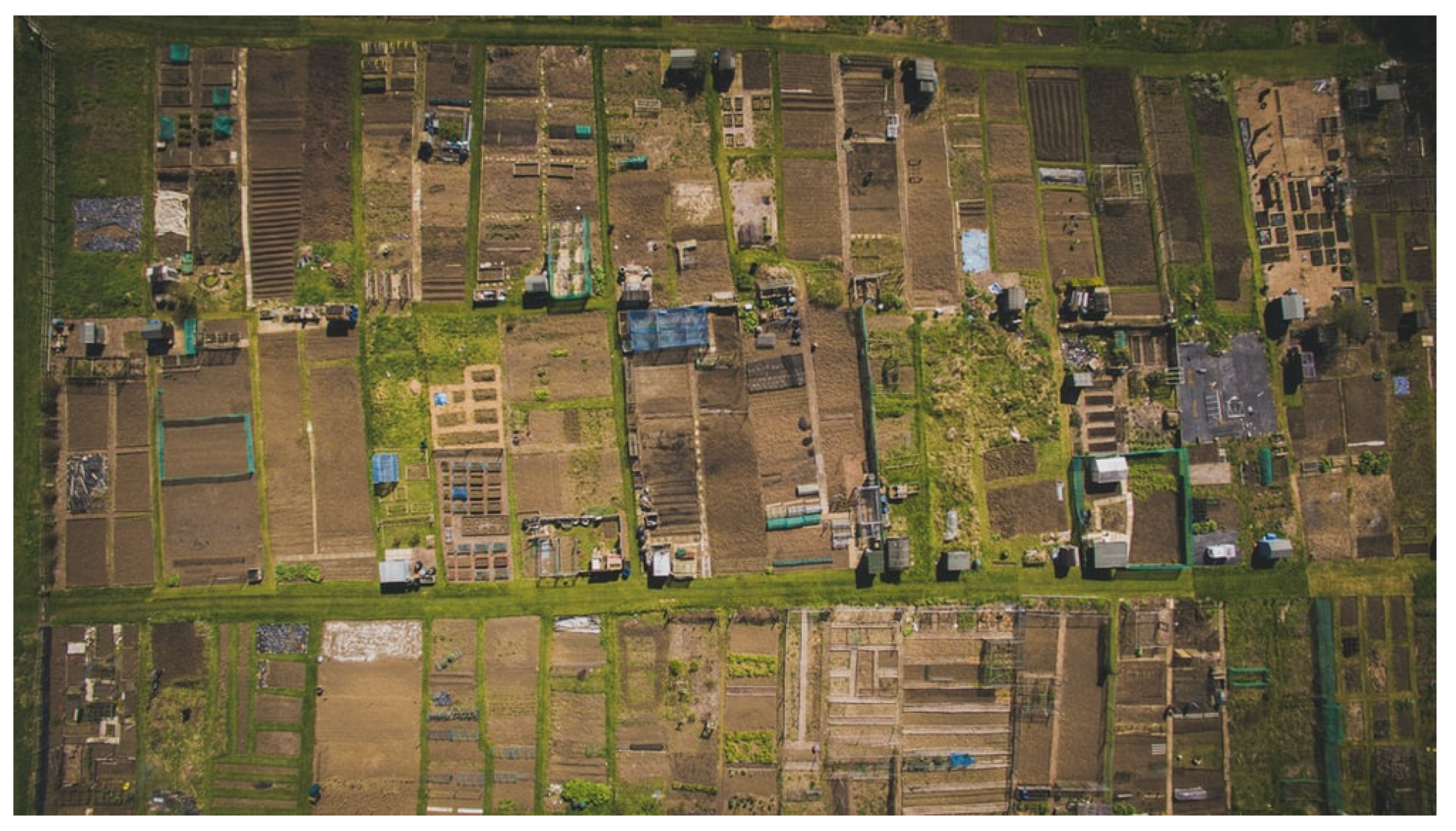
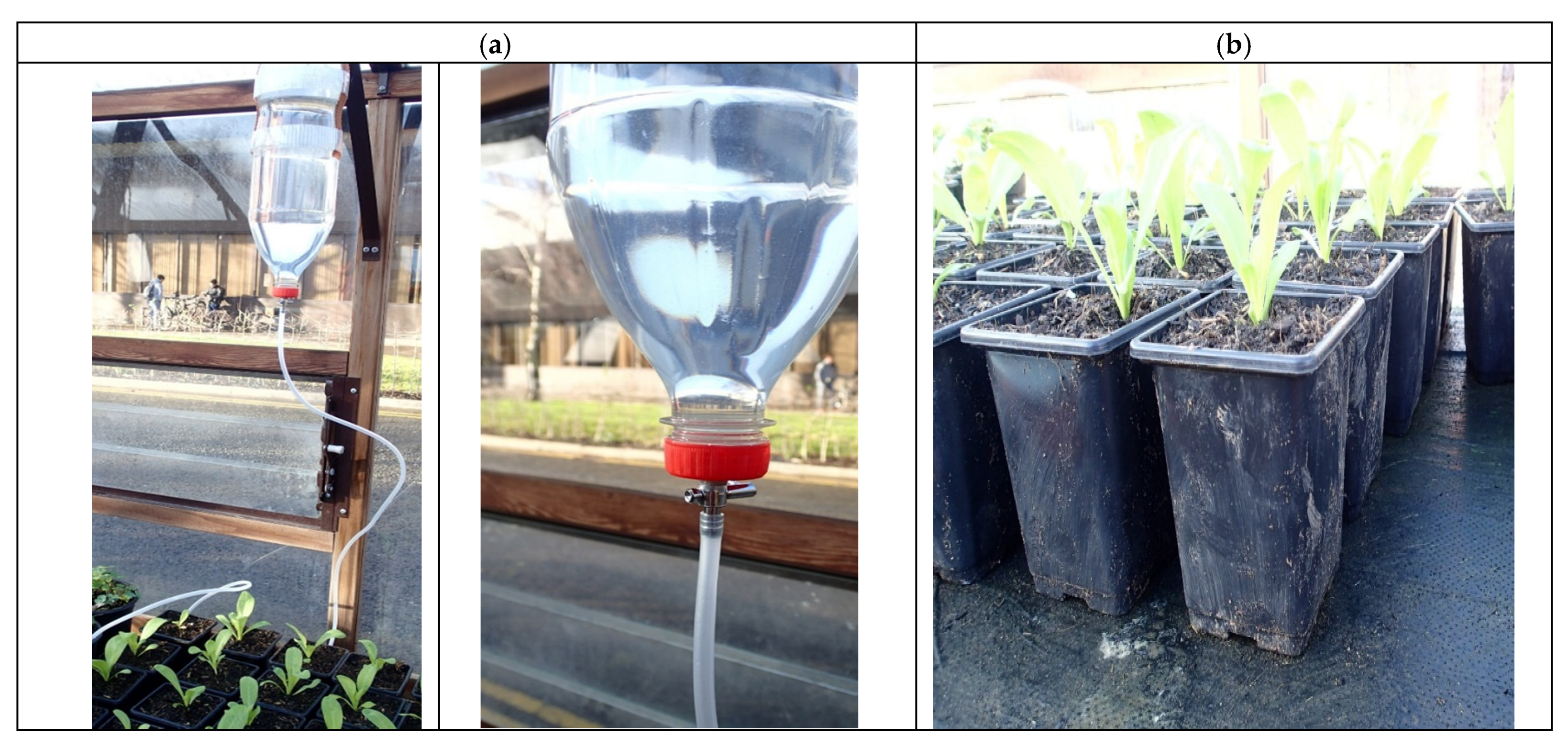
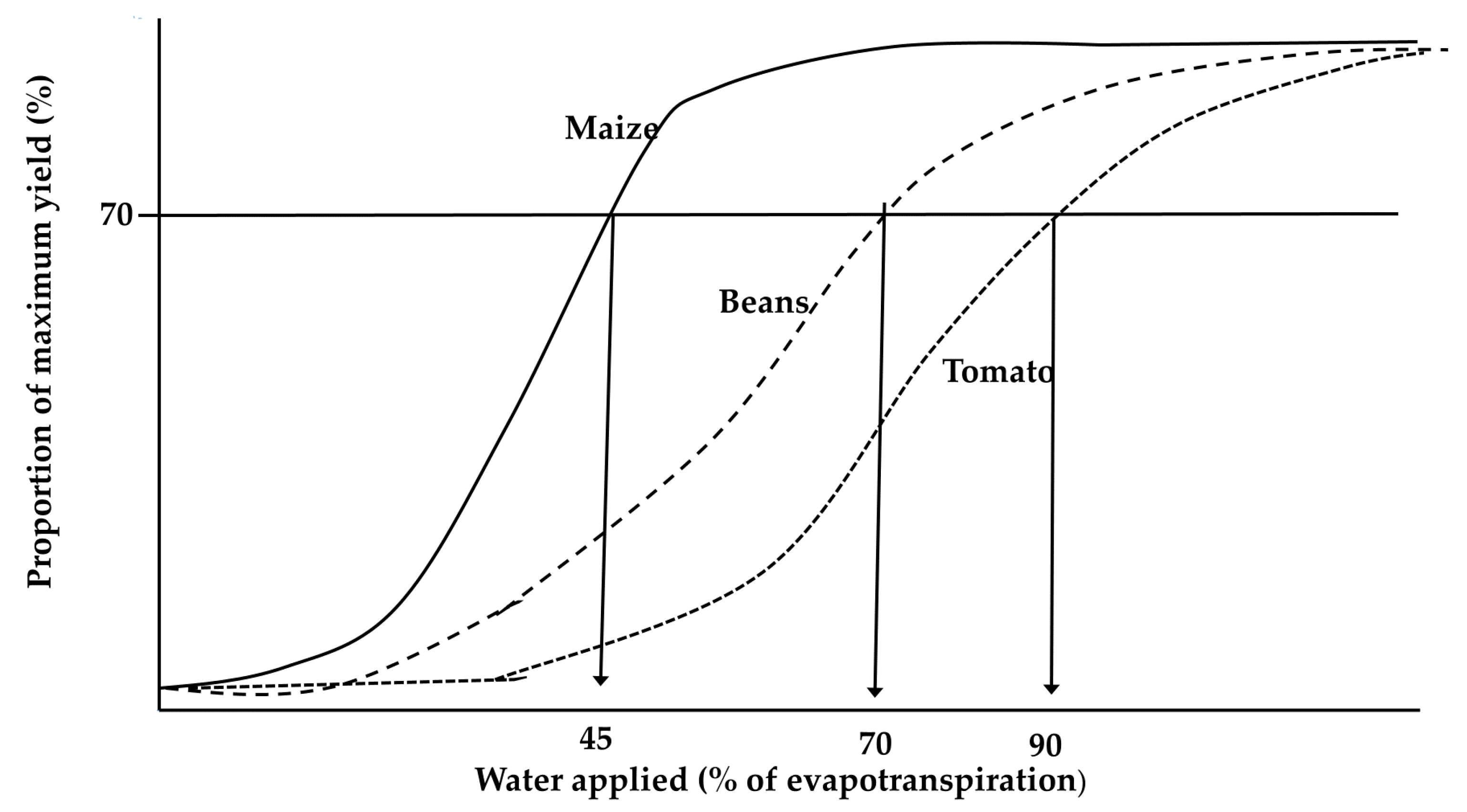
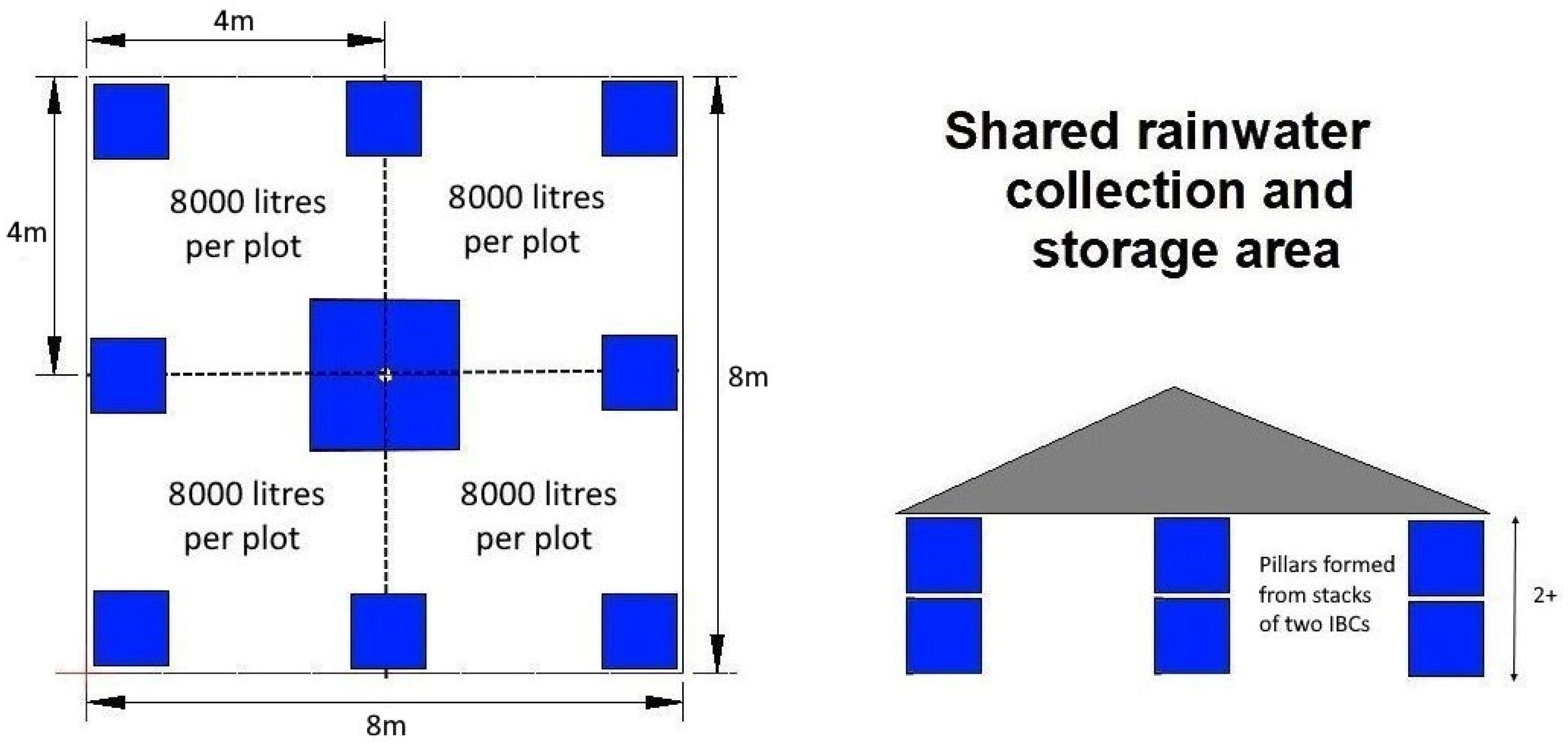
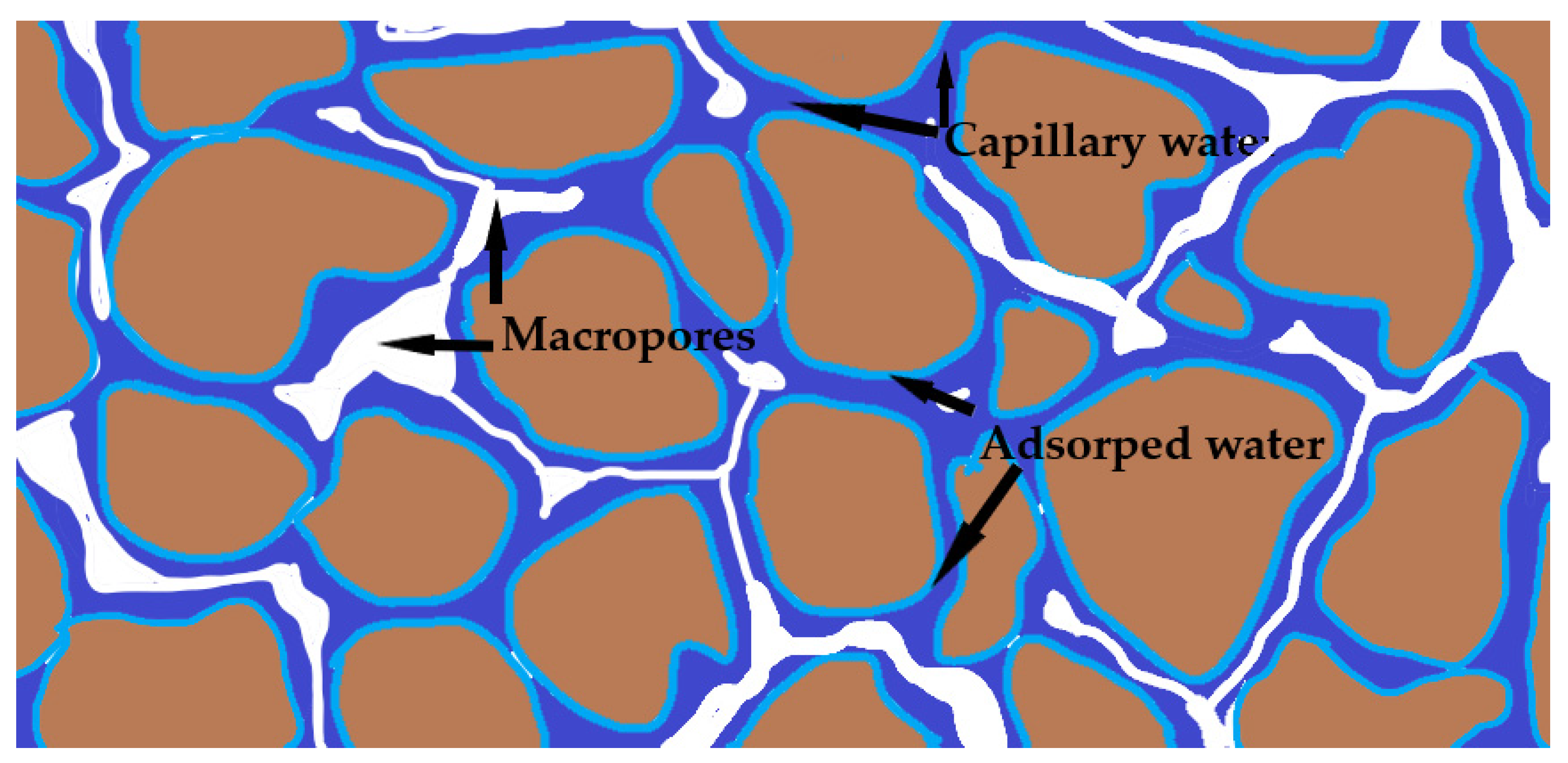

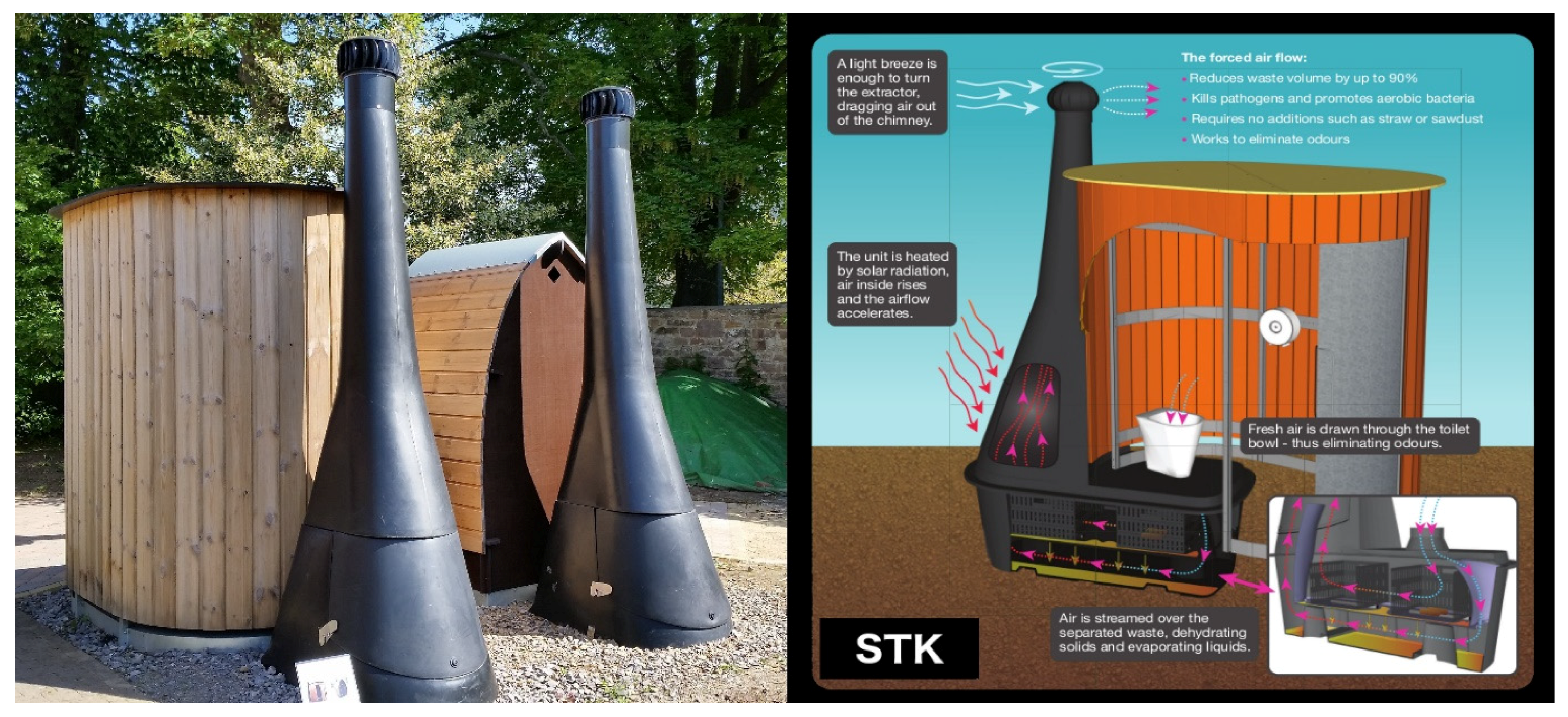
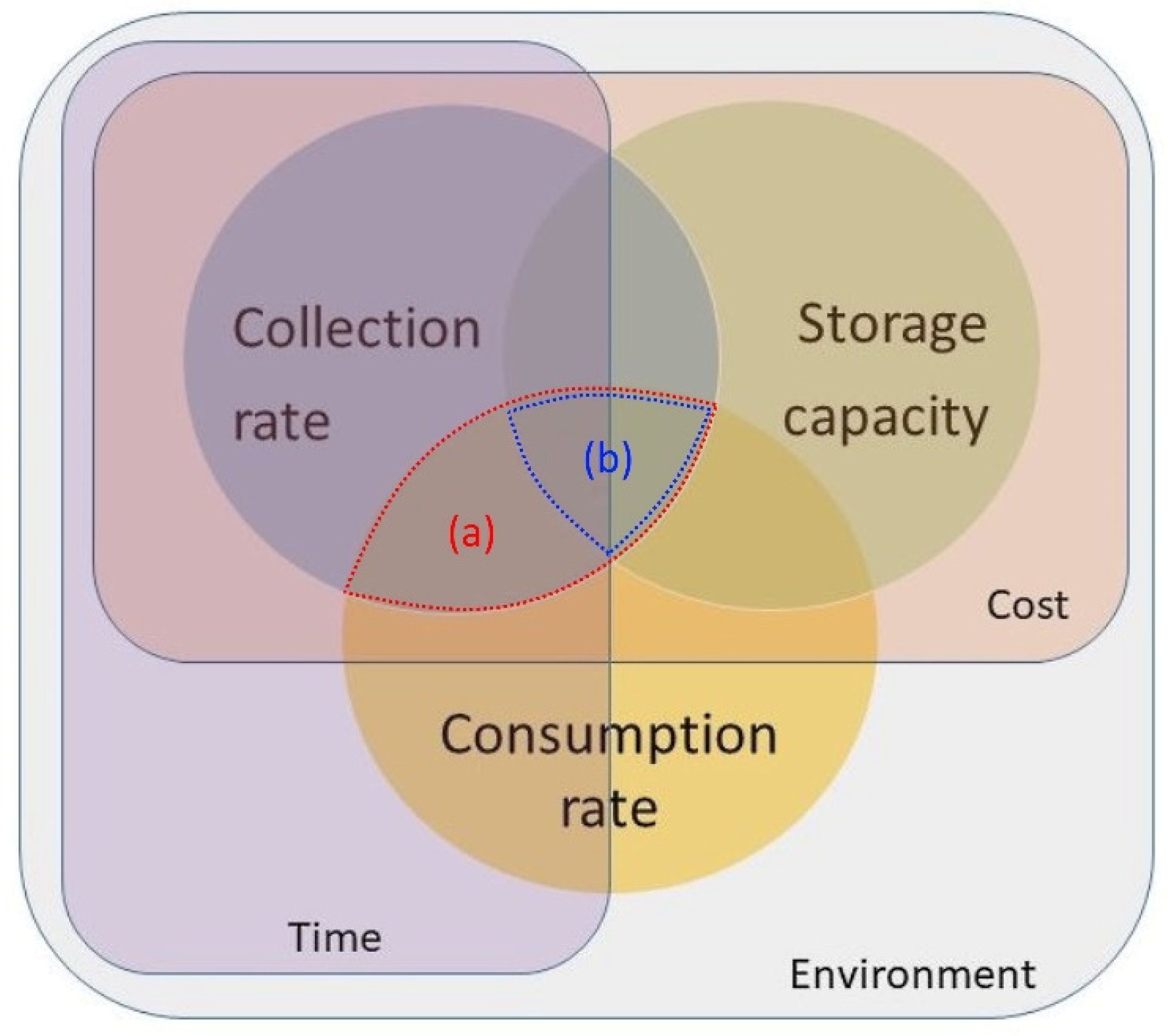
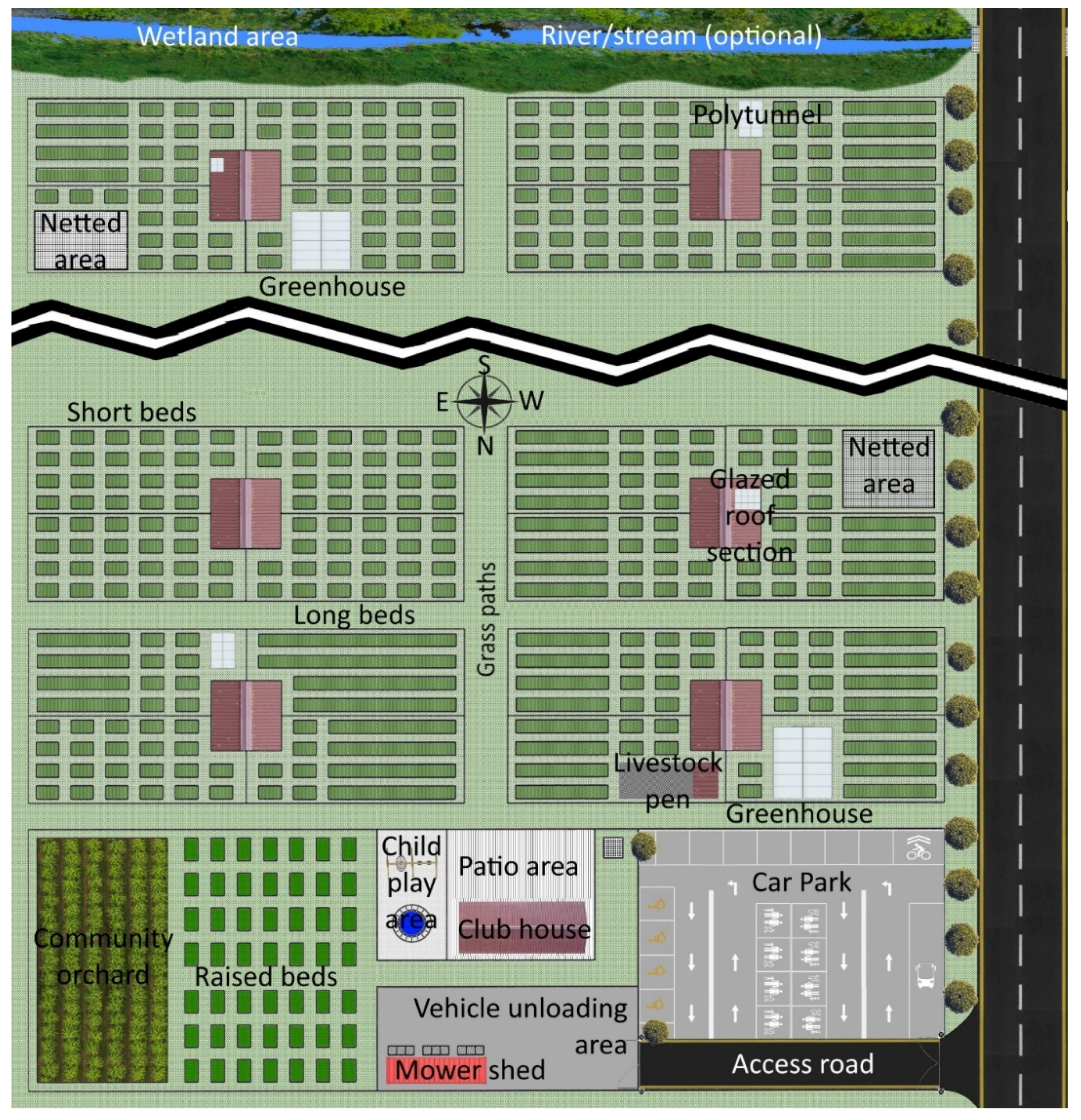
| Time Period | Low Emissions | Medium Emissions | High Emissions | ||||
|---|---|---|---|---|---|---|---|
| Winter | Summer | Winter | Summer | Winter | Summer | ||
| Change in precipitation (%) | 2020s | 4.7 | −6.7 | 5.7 | −7.52 | 6.1 | −8.16 |
| 2050s | 10.3 | −9.5 | 17.24 | −14 | 15.7 | −20 | |
| 2080s | 17.3 | −15.7 | 22.1 | −20 | 23 | −28 | |
| Change in temperature (°C) | 2020s | 1.1 | 1.61 | 1.27 | 1.72 | 1.3 | 1.5 |
| 2050s | 1.7 | 2.32 | 1.89 | 2.4 | 1.9 | 3 | |
| 2080s | 2.1 | 3.08 | 2.6 | 3.6 | 3 | 4.5 | |
| Type of Water | Used for | Amount (Litres) | Comments |
|---|---|---|---|
| Rainwater | Watering plants | Up to 19,000 | See Appendix A for assumptions and calculation, up to 200 L per day per plot during the summer months |
| Cleaning | 250 | 45 L twice each year, for washing pots and seed trays, 45–60 L cleaning a glasshouse and staging. Weekly 2 L to clean hand tools. | |
| Total | 19,250 | ||
| Mains water | Watering glasshouse seeds and seedlings | 200 | Short-term demand, about one month. Mains water recommended to prevent disease [31] |
| Livestock | 6000 | Based on a flock of twelve hens, values for other livestock in File S2 | |
| Handwashing | 520 | Flowrate for a hand basin tap is approximately 10 L min−1. The water flow for 30 seconds is 5 L, i.e., 5 L of water per hand wash. Assuming 5 L per visit, with two visits per week. | |
| Total | 6720 | ||
| Individual | Semi-Distributed | Centralized | |
|---|---|---|---|
| Strengths | Low cost, funded directly by plot holder | ||
| Low complexity, easy to implement & maintain | |||
| Independent control by plot holder | Opportunity for plot holders to customize | ||
| Promotes cooperation between adjoining plot holders | Promotes cooperation across site | ||
| Large storage capacity | Very large storage capacity | ||
| Awareness of stored water level possible | Monitoring/awareness of site’s stored water level | ||
| Weaknesses | Medium cost, funded by site and/or plot holders | High cost, funded by site | |
| Medium complexity, some expertise required | High complexity, specialist knowledge required | ||
| Needs cooperation to set up | Site wide agreement to set up | ||
| Lack of individual responsibility | |||
| Water storage capacity usually less than desirable | |||
| People with limited mobility may not be able set up a system | |||
| Can make site look untidy | |||
| Opportunities | Individual creativity | Develop sense of responsibility towards neighbours | |
| Can be incorporated into other structures (e.g., local shelter & tool storage) | Can be incorporated into other structure (e.g., site hut for communal use) | ||
| Drip irrigation easier to implement due to pressure | Drip irrigation easier to implement due to pressure | ||
| Semi-distributed hubs can be interconnected | |||
| Threats | Lack of maintenance | Who is responsible for repair if it breaks | |
| Site vulnerability to vandals/accident |
| Mono Pitched (Shed Roof) | Dual Pitched (Triangular Prism) | Quad Pitched (Square Pyramid) | |
|---|---|---|---|
| Appearance (only three corner pillars shown for clarity) |  |  | 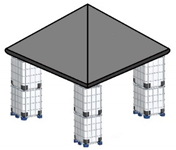 |
| Total rain collection area | 64 m2 | 64 m2 | 64 m2 |
| Rain collection area per plot | 16 m2 | 16 m2 | 16 m2 |
| Roof material with 5° pitch | ~70 m2 | ~64.3 m2 | ~64.3 m2 + waste |
| Ridge height with 5° pitch | ~3.1 m | ~2.7 m | ~2.7 m |
| Roof material with 20° pitch | ~91.4 m2 | ~68.1 m2 | ~68.1 m2 +waste |
| Ridge height with 20° pitch | ~5.3 m | ~3.8 m | ~3.8 m |
| Ridges | 0 | 1 | 4 |
| Total length of guttering | 8 m | 16 m | 32 m |
| Build complexity | Medium | Medium | High |
| Wind aerodynamics | Poor | Average | Good |
| The body of the structure is formed from rigid Intermediate Bulk Container (IBCs) each with a storage capacity of 1000 L and external dimensions of 1000 mm (width), 1200 mm (depth) and 1170 mm (height). The IBCs are double stacked to form pillars in the (four) external corners, in the sides and (four) in the middle. Corrugated sheets of steel (galvanized) and plastic/composite are a cost effective, rigid, roofing material. Alternatively, sheets of wood (e.g., treated plywood or OSB) with appropriate beams could be used. Corrugated sheets allow the roof pitch (e.g., 5°) to be lower than with traditional roofing materials such as tiles & shingles. A 20° pitch provides better debris clearing (including snow) and sounder waterproofness than a flatter pitch. Three roof designs were considered. All three roof types have their own merits. However, on balance it was considered that ‘dual pitched’ offered the best overall solution for this application. In particular, ‘dual pitched’ benefits from efficient use of raw materials and ease of connecting gutters to IBCs. A wide range of structural enhancements are possible to suit the plot holders’ requirements. By way of example:
| |||
| Crop | Compacted Yield/Uncompacted Yield (%) |
|---|---|
| Snap bean | 25 |
| Cucumber | 34 |
| Cabbage | 34 |
| Squash | 30 |
| Sweet Corn | 45 |
| Tomato | 44 |
Publisher’s Note: MDPI stays neutral with regard to jurisdictional claims in published maps and institutional affiliations. |
© 2021 by the authors. Licensee MDPI, Basel, Switzerland. This article is an open access article distributed under the terms and conditions of the Creative Commons Attribution (CC BY) license (https://creativecommons.org/licenses/by/4.0/).
Share and Cite
Ayling, S.M.; Phillips, N.; Bunney, S. Allotments in the Future: Building Resilience to Climate Change through Improved Site Design and Efficient Water Practices. Water 2021, 13, 1457. https://doi.org/10.3390/w13111457
Ayling SM, Phillips N, Bunney S. Allotments in the Future: Building Resilience to Climate Change through Improved Site Design and Efficient Water Practices. Water. 2021; 13(11):1457. https://doi.org/10.3390/w13111457
Chicago/Turabian StyleAyling, Sarah M., Neil Phillips, and Sarah Bunney. 2021. "Allotments in the Future: Building Resilience to Climate Change through Improved Site Design and Efficient Water Practices" Water 13, no. 11: 1457. https://doi.org/10.3390/w13111457
APA StyleAyling, S. M., Phillips, N., & Bunney, S. (2021). Allotments in the Future: Building Resilience to Climate Change through Improved Site Design and Efficient Water Practices. Water, 13(11), 1457. https://doi.org/10.3390/w13111457






